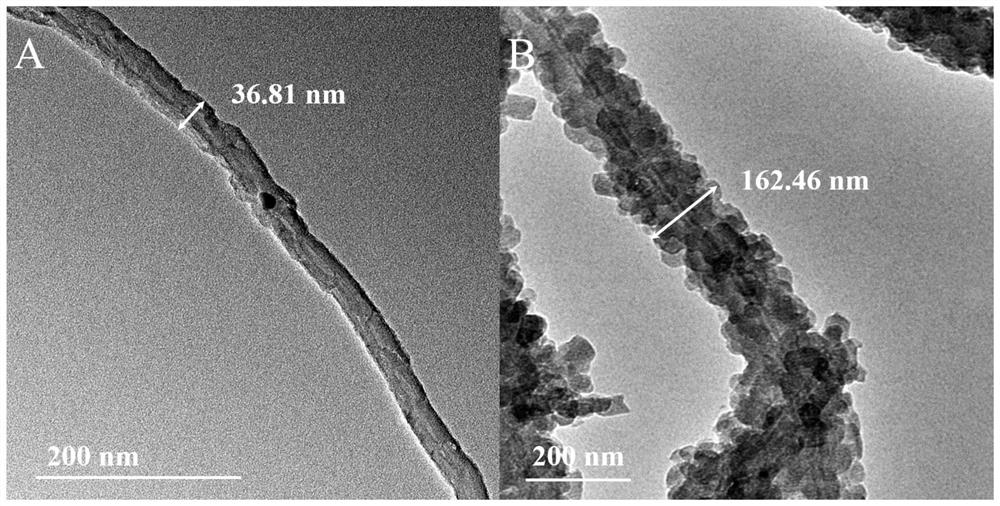Electrochemical enzyme biosensor for detecting organophosphorus pesticide as well as preparation method and application of electrochemical enzyme biosensor
A biosensor and organophosphorus pesticide technology, applied in the field of electrochemical analysis, can solve the problems of complex pretreatment, long detection cycle, difficult sample screening and detection, etc., and achieve the effect of good selectivity, simple operation and fast detection
- Summary
- Abstract
- Description
- Claims
- Application Information
AI Technical Summary
Problems solved by technology
Method used
Image
Examples
Embodiment 1
[0031] A preparation method of an electrochemical enzyme biosensor for detecting organophosphorus pesticides:
[0032] (1) Preparation of covalent organic framework / multi-walled carbon nanotube composites
[0033] Disperse the multi-walled carbon nanotubes in the mixed solution of 1-butanol and 1,2-dichlorobenzene to obtain dispersion A, wherein, every 6mL of the mixed solution of 1-butanol and 1,2-dichlorobenzene Correspondingly, 3 mg of multi-walled carbon nanotubes were added, and the volume ratio of 1-butanol to 1,2-dichlorobenzene in the mixed solution was 1:1.
[0034] Disperse 2,5-dihydroxyterephthalaldehyde and 1,3,5-tris(4-aminophenyl)benzene in acetic acid to obtain dispersion B and dispersion C, in which 2,5-dihydroxyterephthalaldehyde The molar ratio of phthalaldehyde to 1,3,5-tris(4-aminophenyl)benzene is 3:2, and 0.2 mmol of 2,5-dihydroxyterephthalaldehyde is added to every 0.6 mL of acetic acid.
[0035] Ultrasonically mixes the uniform dispersion liquid AB an...
Embodiment 2
[0044] A preparation method of an electrochemical enzyme biosensor for detecting organophosphorus pesticides:
[0045] (1) Preparation of covalent organic framework / multi-walled carbon nanotube composites
[0046] Disperse the multi-walled carbon nanotubes in the mixed solution of 1-butanol and 1,2-dichlorobenzene to obtain dispersion A, wherein, every 6mL of the mixed solution of 1-butanol and 1,2-dichlorobenzene Correspondingly, 24 mg of multi-walled carbon nanotubes were added, and the volume ratio of 1-butanol to 1,2-dichlorobenzene in the mixed solution was 1:1.
[0047] Disperse 2,5-dihydroxyterephthalaldehyde and 1,3,5-tris(4-aminophenyl)benzene in acetic acid to obtain dispersion B and dispersion C, in which 2,5-dihydroxyterephthalaldehyde The molar ratio of phthalaldehyde to 1,3,5-tris(4-aminophenyl)benzene is 3:2, and 0.3 mmol of 2,5-dihydroxyterephthalaldehyde is added to every 0.6 mL of acetic acid.
[0048] Ultrasonically mixes the uniform dispersion liquid AB a...
Embodiment 3
[0057] A preparation method of an electrochemical enzyme biosensor for detecting organophosphorus pesticides:
[0058] (1) Preparation of covalent organic framework / multi-walled carbon nanotube composites
[0059] Disperse the multi-walled carbon nanotubes in the mixed solution of 1-butanol and 1,2-dichlorobenzene to obtain dispersion A, wherein, every 6mL of the mixed solution of 1-butanol and 1,2-dichlorobenzene Correspondingly, 12 mg of multi-walled carbon nanotubes were added, and the volume ratio of 1-butanol to 1,2-dichlorobenzene in the mixed solution was 1:1.
[0060] Disperse 2,5-dihydroxyterephthalaldehyde and 1,3,5-tris(4-aminophenyl)benzene in acetic acid to obtain dispersion B and dispersion C, in which 2,5-dihydroxyterephthalaldehyde The molar ratio of phthalaldehyde to 1,3,5-tris(4-aminophenyl)benzene is 3:2, and 0.24 mmol of 2,5-dihydroxyterephthalaldehyde is added to every 0.6 mL of acetic acid.
[0061] Ultrasonically mixes the uniform dispersion liquid AB ...
PUM
| Property | Measurement | Unit |
|---|---|---|
| diameter | aaaaa | aaaaa |
Abstract
Description
Claims
Application Information
 Login to View More
Login to View More - R&D
- Intellectual Property
- Life Sciences
- Materials
- Tech Scout
- Unparalleled Data Quality
- Higher Quality Content
- 60% Fewer Hallucinations
Browse by: Latest US Patents, China's latest patents, Technical Efficacy Thesaurus, Application Domain, Technology Topic, Popular Technical Reports.
© 2025 PatSnap. All rights reserved.Legal|Privacy policy|Modern Slavery Act Transparency Statement|Sitemap|About US| Contact US: help@patsnap.com



